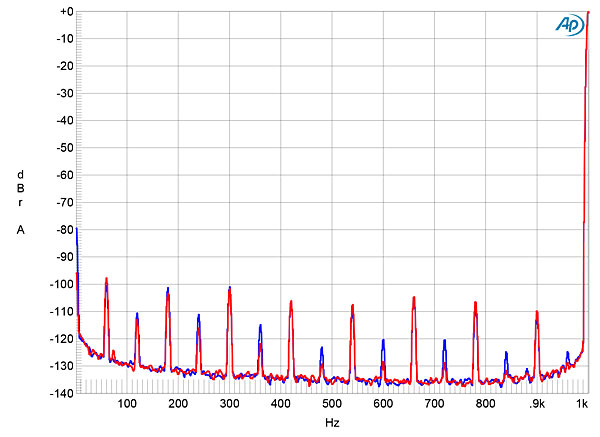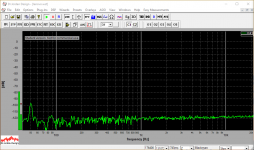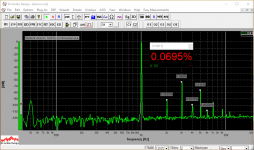Very interesting your new amp.
Simpelstark PLUS V1.3 kit (2 x PCBs + parts) – Virtual Zero Audio Store
SNR A-weighted at 1 watt and 100 watts?
Post your Solid State pics here.
Hi Maty,
I have actually never measured its SNR some proper way, as I didn't see any practical reason for that - it's one of the quietest amplifiers I ever dealt with
Anyway, if I have time, I will measure it for the marketing purpose
Cheers,
Valery
Last edited:
Hi Maty,
I have actually never measured its SNR some proper way, as I didn't see any practical reason for that - it's one of the quietest amplifiers I ever dealt with
Anyway, if I have time, I will measure it for the marketing purpose
Cheers,
Valery
By the way, I don't see any sense in measuring the SNR of a power amp at 1W if you know the SNR value at 100W. Just take the one at 100W and subtract 40db, right? The signal is 40db lower, the noise is the same.
By the way, I don't see any sense in measuring the SNR of a power amp at 1W if you know the SNR value at 100W. Just take the one at 100W and subtract 40db, right? The signal is 40db lower, the noise is the same.
In theory, you need to substract 20 dB.
In theory, you need to substract 20 dB.
Right! 100 times in power = 10 times in Vrms.
My mistake.
The problem with the SNR is in how it has been measured. Very few times the manufacturers specify it!
To be able to compare the easiest is to use A-wighted to 1 watt / 8 Ohms.
An example, John Atkinson (Stereophile) with Pass Labs XA200.8:
Pass Laboratories XA200.8 monoblock power amplifier Measurements | Stereophile.com
To be able to compare the easiest is to use A-wighted to 1 watt / 8 Ohms.
An example, John Atkinson (Stereophile) with Pass Labs XA200.8:
Pass Laboratories XA200.8 monoblock power amplifier Measurements | Stereophile.com
The unweighted, wideband signal/noise ratio, ref. 1W into 8 ohms and taken with the input shorted to ground, was an excellent 83dB. This improved to 88.2dB when the measurement bandwidth was restricted to the audioband—and was even better, at 92.1dB, when the measurement was A-weighted. Like the other Pass Labs amplifiers we have reviewed, the XA200.8 is quiet.
As with the XA60.8 monoblock that we reviewed in December 2017, both the odd and even harmonics of the 60Hz power-supply frequency were present in the amplifier's noise floor, though these all lay at or below –100dB ref. 1W into 8 ohms (fig.3).

Fig.3 Pass Labs XA25, spectrum of 1kHz sinewave, DC–1kHz, at 1W into 8 ohms (linear frequency scale).
Last edited:
SNR
OK, guys... it appeared to be not that easy with the gear I have in hand.
My True RMS voltmeter has got the resolution of 100uV and it shows 000.0 mV with no signal at the output.
I switched to the oscilloscope - minimum value it can measure is 80uV, however, it also shows zero. OK, let's take the worst value that would be rounded down to zero - that would be 39uV of the noise signal.
That gives us:
SNR (2.83V) = 97db (1W @ 8 ohm)
SNR (28.3V) = 117db (100W @ 8 ohm)
Then I have connected my audio analyzer and tried to see the spectrums.
The first picture shows the spectrum with the amplifier off.
We see a 50Hz artifact - some kind of a ground loop caused by the way the analyzer is connected to the amplifier.
The second picture is 28.3V RMS output (same measurement scale, I didn't touch any settings) - we see the same artifact a little bit grown up, all the rest is very close to the "off" situation.
That's the best I can do at the moment. Need some uV RMS meter for more precise measurements.
OK, guys... it appeared to be not that easy with the gear I have in hand.
My True RMS voltmeter has got the resolution of 100uV and it shows 000.0 mV with no signal at the output.
I switched to the oscilloscope - minimum value it can measure is 80uV, however, it also shows zero. OK, let's take the worst value that would be rounded down to zero - that would be 39uV of the noise signal.
That gives us:
SNR (2.83V) = 97db (1W @ 8 ohm)
SNR (28.3V) = 117db (100W @ 8 ohm)
Then I have connected my audio analyzer and tried to see the spectrums.
The first picture shows the spectrum with the amplifier off.
We see a 50Hz artifact - some kind of a ground loop caused by the way the analyzer is connected to the amplifier.
The second picture is 28.3V RMS output (same measurement scale, I didn't touch any settings) - we see the same artifact a little bit grown up, all the rest is very close to the "off" situation.
That's the best I can do at the moment. Need some uV RMS meter for more precise measurements.
Attachments
ODNF
Searching info about ODNF I found:
ODNF or no GNFB power amp
No-global-loop amplification
Investigation of feed back techniques 12 by Paulius Jurkstas
[PDF] Paulius_Jurkstas_investigation_of_feed_back_techniques.pdf - Google Drive
Searching info about ODNF I found:
ODNF or no GNFB power amp
No-global-loop amplification
Investigation of feed back techniques 12 by Paulius Jurkstas
[PDF] Paulius_Jurkstas_investigation_of_feed_back_techniques.pdf - Google Drive
Chapter 1
Theory
Two distortion reduction techniques were investigated:
• Hawksford’s distortion correction technique for unity gain output stage (Hawksford’s stage or EC) [1]
• Only distortion negative feedback (ODNF) [2]
Both techniques use feedback to reduce distortion. The main difference from a regular negative feedback systems is that in these techniques only distortion signal is fed back.
Last edited:
H2 dominance
No-global-loop amplification
No-global-loop amplification
I have no idea about the soundcard performance, plus a high-sensitivity microphone input adds a lot of noise, but we can still see the harmonics profile and the way ODNS suppresses high-order harmonics. This is 25W output @ 8ohm resistive load.
H2 is reduced by 6db; H3, H5 and H7 - by around 15db - resulting in excellent profile with H2 dominance and rather low higher order components.
Last edited:
- Status
- This old topic is closed. If you want to reopen this topic, contact a moderator using the "Report Post" button.
- Home
- Vendor's Bazaar
- VHex+ amplifier modules, kits and boards

